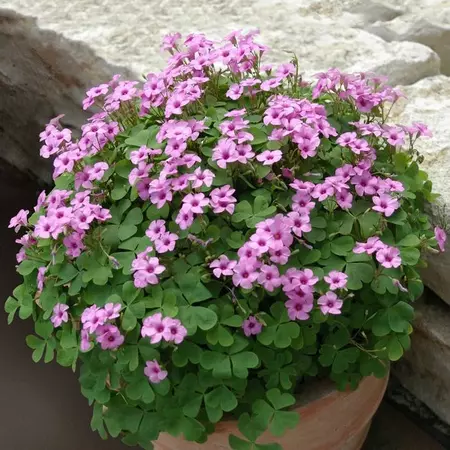Oxalis Triangularis , Butterfly Plant Green – Corm (Bulb)
Original price was: ₹555.00.₹99.00Current price is: ₹99.00.
Out of stock
Email when stock available
Selling Part: Single Corm (Bulb)
Oxalis triangularis, often called the Butterfly Plant, False Shamrock, or Purple Shamrock (even the green-leafed variety shares similar care, just with green foliage), is known for its beautiful, triangular leaves that often fold up at night or in low light. These plants grow from corms (often mistaken for bulbs), which are underground storage organs.
Here’s a comprehensive guide to caring for your green Oxalis triangularis, with a special focus on its corms:

General Care for Oxalis Triangularis (Green)
1. Light:
- Bright, indirect light is ideal. Place it near a window where it receives plenty of light but is shielded from harsh, direct afternoon sun, which can scorch the leaves.
- Some morning or evening direct sun is usually fine and can help keep the plant compact.
- If your plant becomes leggy or its leaves close more often during the day, it’s likely not getting enough light.
2. Watering:
- Water thoroughly when the top 1-2 inches of soil feel dry to the touch.
- Allow excess water to drain completely from the bottom of the pot. Never let the plant sit in standing water, as this can lead to corm rot.
- Water more frequently during the active growing season (spring and summer) and reduce watering in colder months or during dormancy.
3. Humidity:
- Oxalis triangularis generally tolerates average household humidity.
- If your indoor air is very dry, especially in winter, consider placing the pot on a pebble tray with water or using a humidifier nearby.
4. Temperature:
- Ideal temperatures are between 65-75°F (18-24°C).
- Avoid extreme temperature fluctuations, drafts, or temperatures below 60°F (15°C).
- Temperatures consistently above 80°F (27°C) can trigger premature dormancy.
5. Soil and Potting:
- Use a well-draining potting mix. A mix designed for African violets or succulents can work well, or you can create your own by mixing equal parts peat moss, perlite, and regular potting soil. Good drainage is crucial to prevent corm rot.
- Repot every 1-2 years or when you notice the plant becoming root-bound. Choose a slightly larger pot with drainage holes.
- Oxalis corms multiply rapidly, so ensure your pot is deep enough to accommodate their growth.
6. Fertilizing:
- Feed with a balanced, water-soluble fertilizer every 4-6 weeks during the active growing season (spring and summer).
- Dilute the fertilizer to half the recommended strength to prevent overfeeding.
- Stop fertilizing when the plant enters dormancy.
7. Pruning:
- Trim any yellowing, dead, or leggy foliage to maintain a tidy appearance and encourage bushier growth.
Corm (Bulb) Care – Planting and Dormancy
Oxalis triangularis grows from small, pinecone-shaped corms. These plants naturally go through periods of dormancy.
Planting Corms:
- Choose a well-draining potting mix. Amend it with perlite or sand for extra drainage if needed.
- Select a pot with drainage holes.
- Plant the corms about 1-2 inches (2-4 cm) deep and 1-2 inches apart. You can plant them with the narrow, tapered end pointing up, but they will still grow even if placed sideways or upside down (it just might take a bit longer).
- Water lightly after planting. Avoid overwatering until new growth appears.
- New growth typically emerges in about 3-6 weeks.
Dormancy:
- Understanding Dormancy: Oxalis triangularis often enters a dormant phase, usually in late summer or autumn, but it can occur at other times, especially if the plant experiences stress (e.g., too much heat, too little light, or inconsistent watering). The leaves may wilt, droop, turn yellow, and die back completely. This is a natural part of its life cycle and does not mean your plant is dying!
- During Dormancy:
- Stop watering completely once the leaves have died back.
- Stop fertilizing.
- Move the pot to a cool, dark, and dry place (like a cupboard, basement, or shaded shelf) for 4-6 weeks, or even up to 2-3 months. The ideal temperature during dormancy is around 50-60°F (10-15°C).
- Waking from Dormancy:
- After the dormancy period, bring the pot back to a bright, indirect light location.
- Begin watering lightly. Do not drench the soil. As you see new growth emerging, gradually increase watering.
- Resume fertilizing once new growth is established.
- If the corms are still firm, they are viable and will likely sprout new growth.
Propagating Corms:
- Dormancy is the perfect time to divide your Oxalis corms. Once the foliage has died back, carefully unearth the corms from the soil.
- Gently separate the individual corms or clumps of corms.
- Replant them in fresh potting mix as described above to create new plants.
Common Problems and Solutions:
- Leggy, spindly growth: Insufficient light. Move to a brighter location.
- Yellowing leaves/mushy stems: Overwatering or poor drainage leading to root/corm rot. Reduce watering frequency, ensure good drainage, and check for rot.
- Wilting/crispy edges: Underwatering or low humidity. Water more consistently and consider increasing humidity.
- No new growth/plant appears “dead”: Likely in dormancy. Follow the dormancy care steps.
By understanding the needs of its corms and providing consistent care, your green Oxalis triangularis will thrive and bring delightful movement and foliage to your space!
Only logged in customers who have purchased this product may leave a review.















 If you need any assistance, I'm always here. Have you found what you were looking for?
If you need any assistance, I'm always here. Have you found what you were looking for?
Reviews
There are no reviews yet.